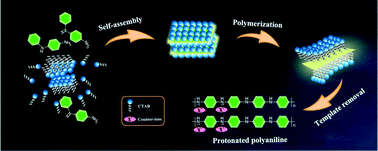Regulating the species and the counter-ion size of proton acids to prepare novel poly(4-aminodiphenylamine) nanomaterials for supercapacitors†
Abstract
Poly(4-aminodiphenylamine) (P(4-ADPA)) is a kind of polyaniline derivative and is promising as one of the alternatives to polyaniline because its monomer has a lower oxidation standard potential for oxidation and a faster oxidation rate than that of the aniline monomer. Herein, to explore the factors affecting the structural and electrochemical properties of novel conducting P(4-ADPA) materials, a series of P(4-ADPA) has been prepared by using different organic or inorganic proton acids as dopants and a cationic surfactant as the structure-directing agent. The result shows that the shape and stability of the self-assembled surfactant lamellar micelles are strongly affected by the species and the counter-ion size of proton acids, which in turn affects the morphology, crystallinity and the electrochemical properties of P(4-ADPA). Specifically, P(4-ADPA)-L with lactic acid as the dopant under a mild polymerization environment possesses a uniform intertwined nanosheet morphology and shows superior electrochemical properties with a high specific capacitance of 388 F g−1 at 0.5 A g−1 and a superlong cycle stability. In addition, P(4-ADPA)-S and P(4-ADPA)-P with sulfuric acid and perchloric acid as dopants, respectively, exhibit high conductivity and specific capacitance, and due to the high acidity of reaction solutions, a large size of counter-ions and thereby good crystallinity.



 Please wait while we load your content...
Please wait while we load your content...